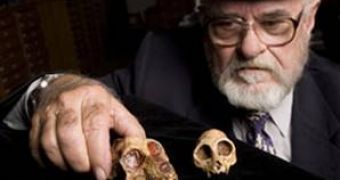What best characterizes a monkey or an ape?
It's the big brain.
But when researchers got a new fossil of a common ancestor of monkeys and apes (humans included), they found out that the 29 million-year-old creature has not such a big brain as expected.
"The finding indicated that primate brain enlargement evolved later than once thought," said the scientists involved in the research.
They have investigated a remarkably well-preserved fossilized skull of Aegyptopithecus zeuxis, the "Dawn ape", an arboreal creature feeding on fruit and leaves in the warm Oligocene forests located in the area of the present-day Egyptian desert.
The microcomputerized tomography scanning revealed the brain size of the animal.
"What was astonishing is how small this brain is," said lead researcher Elwyn Simons, primatologist at Duke University.
"You can also see it's a pretty darn primitive brain. It would be small for a monkey or an ape. So it's telling us that the speed of achievement of brain enlargement in primates was a little slower than perhaps we had thought." said Simons.
This female skull was discovered near Cairo in 2004 while a worse preserved larger male skull was encountered in the same area in 1966.
The 1966 discovery made the researchers believe Aegyptopithecus possessed a relatively large brain, due to the bigger size of the male skull, given its bigger snout and larger crests, while in reality its brain seems to have been smaller than that of a modern lemur, a primitive primate type.
During Oligocene era, Africa was an island like Australia, with low competition.
"Brain enlargement may have evolved in this lineage after Africa became connected to Asia, bringing in more animals including new and dangerous predators. Brain-volume enlargement is favored under conditions of competition because you need to be smarter," Simons said.
"It looked somewhat like an ape, particularly in its teeth and skull, and it is thought to be close to the ancestry of monkeys, apes and humans. Because of the proportions of having a fairly robust chewing mechanism and a small brain, its skull looks like an ape's skull. It looks like a miniaturized gorilla," he added.
The female skull is half the size of the male's and the female individual could have weighed about 5.5 pounds (2.5 kg), while the male was twice that size, a sexual dimorphism similar to gorillas'.
Aegyptopithecus seems to originate from lemurlike ancestors.
But its brain's visual cortex was well developed, thus it had the very good vision of monkeys and apes, being nocturnal, while all primitive primates in Africa (except Madagascar) and Southern Asia are nocturnal.
Primates is the mammalian order including lemurs, monkeys, apes and humans
The Strepsirrhini, or "wet-nosed" primates (lemurs and lorises) split off around 63 million years ago
Old World monkeys and apes divided from New World monkeys about 40 million years ago
The apes split from Old World monkeys about 25 million years ago
Humans and chimpanzees diverged 4 million years ago

 14 DAY TRIAL //
14 DAY TRIAL //